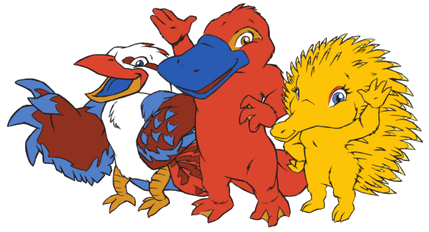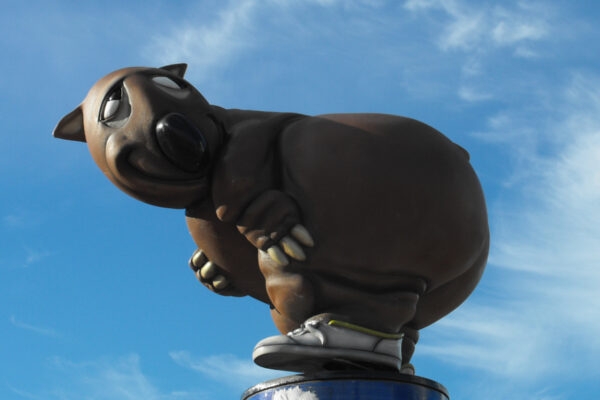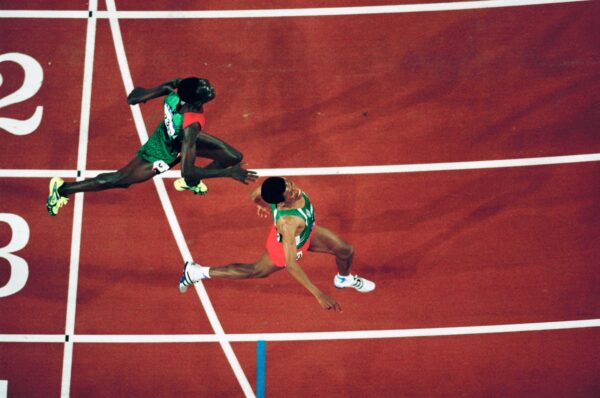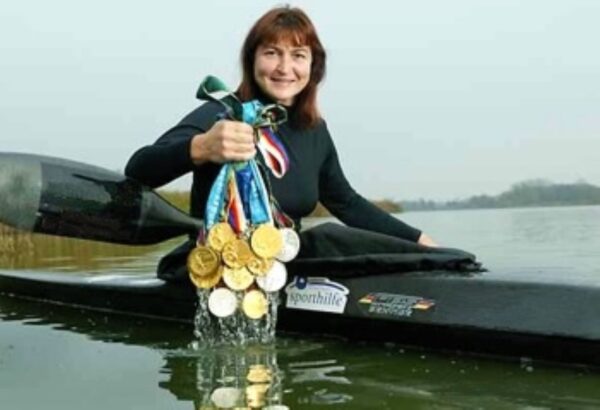The Summer Games returned to Australia a mere forty-four years after Melbourne served as the host city when Sydney came from behind to win the bid over Beijing on the fourth round of voting in 1993. The other bidders were Istanbul, Berlin, and Manchester (England England). Specific figures are hard to pin down but, as nearly as I can tell, the cost to stage the 2000 Sydney Games was about 10 times the expenditures attributed to the 1956 Melbourne Games.
Some other facts and figures
Competition Dates: 13 September – 1 October 2000.
Opening Ceremony: 15 September 2000.
Venues constructed: 12 The largest is Stadium Australia (now Accor Stadium).

[From Accor website]
Competing teams: 200 comprised of 199 National Olympic Committees and four athletes from East Timor who competed under the designation of Individual Olympic Athletes.
Competitive disciplines: 39. These ranged alphabetically from Archery to Wrestling and had 300 medal events within them. Triathlon and taekwondo made their debuts as Olympic medal sports.
Athletes competing: 10,647 of whom 6,579 were men and 4,068 were women. (Melbourne had 3,190 with 2,819 men and 371 women.) The United States sent the largest team with 586 athletes and the British Virgin Islands the smallest with 25-year-old Keita Cline as its only member.
Media: 16,033. Enough said.
Medal count leaders: United States 98 (37 gold; 24 silver; 32 bronze); Russian Federation 89 (32 gold; 28 silver; 29 bronze); Peoples Republic of China 58 (28 Gold; 16 silver; 14 bronze).
Official mascots: Three – named Olly, Syd, and Millie.

[From Wikipedia – By Matthew Hattan and Jozef Szekeres – https://stillmed.olympic.org/media/Document%20Library/OlympicOrg/Factsheets-Reference-Documents/Games/Mascots/Reference-document-OG-Mascots-from-Munich-1972-to-Rio-2016.pdf, Fair use.]
According to Wikipedia,
Olly, Syd and Millie were named by Philip Sheldon from advertising agency DMBB and represented air, soil and water. Olly (from Olympics) the kookaburra represents the Olympic spirit of generosity. Syd (from Sydney) the platypus represents the environment as well as the activity and energy of Australia and their population. Millie (from Millennium) the echidna knows everything about technology and numerical data. The mascots were designed by Matthew Hattan and Jozef Szekeres.
Of course, the Australians being Australian, had to have a little fun with this. Sydney cartoonist Paul Newell with Roy and HG from the Australian Channel Seven sports/comedy television program The Dream with Roy and HG created Fatso, the Fat-Arsed Wombat to serve as the unofficial mascot for the Games.

[From Wikipedia By Saberwyn – Own work, CC BY-SA 3.0.]
If you’re wondering what a real wombat looks like:

Performances worth remembering
In Athletics:.
On 28 September, Susanthika Jayasinghe finished the 200 meter sprint in 22.28 seconds and was awarded a bronze medal. It was the first Olympic medal of any kind for an athlete from her home nation of Sri Lanka. In 2007, her bronze turned to silver when the race winner, American Marion Jones was stripped of her gold medal (and four other medals) when she admitted she had taken performance enhancing steroids.
In other firsts, Maria Mutola won Mozambique’s only Olympic gold medal when she captured the 800 meter title. In something of a double first, American Stacy Dragila outdueled Australian Tatiana Grigorieva to win the first ever women’s pole vault. The Bronze medalist, Vala Flosadóttir from Iceland became the first woman from her country to win an Olympic medal.
In 1996 in Atlanta , Haile Gebrselassie of Ethiopia edged Paul Tergat of Kenya and won the men’s 10,000 meters by just over one second. The pair met again in Sydney with Tergat leading for much of the race. However, Gebrselassie’s closing kick got him past Tergat in the final 20 meters . He defended his Olympic title winning by a margin of nine one-hundredths of a second which was three one-hundredths of a second less than Maurice Greene’s winning time over Ado Boldon in the 100 meter final.

[Image from World Athletics.]
In Swimming:.
The biggest splash in the pool likely came from Ian Thorpe. The 17-year-old Australian set a new world record in the 400 meter freestyle and finished the competition with five medals – three gold and two silver – placed around his neck.
Although he failed to win a medal in his only race, finishing fifth in the 200 meter butterfly, the Sydney games saw the first appearance of a 15-year-old American who would become the most decorated Olympian in history. His name is Michael Phelps.
In the women’s competition, Inge de Bruijn of the Netherlands won three gold medals while setting world records in the 100 meter butterfly and 50 meter freestyle events.
And a few odds and ends:.
Great Britain’s Steven Redgrave won his first Olympic gold medal in the coxed four rowing event in Los Angeles in 1984. (Per Wikipedia, “A coxed four, abbreviated as a 4+, is a racing shell used in the sport of competitive rowing. It is designed for four persons who propel the boat with sweep oars and is steered by a coxswain.”) Redgrave also won a gold medal in the coxless four in Sydney in 2000. His achievement is all the more remarkable because he also won gold medals in 1988 (Seoul), 1992 (Barcelona), and 1996 (Atlanta) making him the only male athlete to win gold medals at five consecutive Olympic Games.
Switzerland’s Brigitte McMahon won the inaugural women’s triathlon. She overcame a 10 second deficit in the running portion to snatch the gold medal from the pre-race favorite Australian Michelie Jones.
The United States won all eight of its games in men’s basketball claiming the gold medal in rather workmanlike fashion. Vince Carter provided one particularly memorable moment:.
Perhaps the greatest upset of the Games came in the super-heavyweight class in Greco-Roman wrestling. Russian Aleksandr Karelin faced American Roulon Gardner in the gold medal match. Not only had Karelin not lost a match in 13 years, he hadn’t been scored upon in six. Gardner scored the lone point of the match when Karelin broke his grip in the clinch in the second period resulting in a one point penalty. Gardner held-off the efforts of Aleksandr the Great and celebrated his victory with a cartwheel and a somersault (or as my Mom would have called it, a purzelbaum).
Meet Birgit Fischer
Among the pleasures I find in Olympics research is unearthing stories about athletes that are little know to me and, I assume, equally little known to most of this blog’s readers. Sometimes it’s their personal story that captures my attention and other times it’s their athletic achievements. Occasionally, it’s both. In the case of Germany’s Birgit Fischer, it’s primarily her athletic accomplishments.
Birgit Fischer competes in a sport that few Americans (including me) pay any attention to even during the Olympics.

[Photo from Stadtmuseum Brandenburg.]
And what she does can be a little confusing. The first line of her biography on World Paddle Awards is, “Birgit Fischer is, without a doubt, the greatest female paddler (in kayak sprint) of all time.” The Wikipedia list of multiple Olympic gold medal winners lists her sport as canoeing. Let’s go with paddling.
Birgit Fischer competed in her first Olympic Games in one that most Americans (including me) ignored – mainly because we had no choice. That would be the 1980 Games in Moscow that the West boycotted. Representing the German Democratic Republic (East Germany) 18-year-old Birgit won the 500 meter single sprint and became the youngest gold medalist in the history of her sport – a title she still holds.
Because of the Eastern bloc boycott, Fischer didn’t compete in the 1984 Games in Los Angeles. However, she returned to compete in Seoul in 1988 where she won a pair of gold and one silver medal. She won gold and silver in Barcelona in 1992 and again in Atlanta in 1996. Twenty years after her first Olympic Games, Birgit Fischer came to Sydney as the holder of five gold medals and two silver.
On 30 September, as part of Germany’s four person 500 meter team, Fischer became the first woman to win gold medals twenty years apart. She won another gold medal the following day in another 500 meter race with teammate Katrin Wagner. But Fischer wasn’t quite done making Olympic history. She’d return to the Games in Athens four years later to defend her K+4 medal in the 500 meters and became the oldest gold medalist in the history of her sport – a title she still holds.

[Photo from Pinterest – Gavin Douglas.]
Yes, Birgit Fischer is at once the youngest and oldest Olympic champion in her sport.